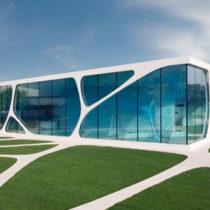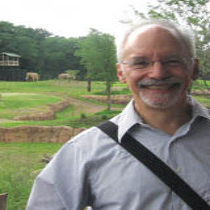Landscape Architecture for Landscape Architects › Forums › SUSTAINABILITY & DESIGN › Quality Design
- This topic has 1 reply, 9 voices, and was last updated 15 years, 1 month ago by
 Trace One.
Trace One.
-
AuthorPosts
-
October 27, 2010 at 8:14 pm #167198
 Trace OneParticipant
Trace OneParticipantno, using the runnal at Salk for communication cables is a good example of design not meeting needs – I think Lou Kahn would roll over in his grave if he knew communication cables were put in his stark little runnal, designed for water and reminiscent of the Alhambra..
it is an example of design being too design-y, and not functioning unless the users intervene to provide functionality, despite what the architect wants..The Seagram Building’s windows I think offer a similar story – designed to have shades that only are allowed to go 1/3 down, or completely down, the human users of the building had to wrestle with the designers restrictions until it worked for them..(i.e., break the shades..)
and I might add, to Tanya – pretty writing, funny stories..thanks!
October 27, 2010 at 9:32 pm #167197 Andrew Garulay, RLAParticipant
Andrew Garulay, RLAParticipantIntended duration of the landscape would be part of the design criteria. A residential landscape typically has a much shorter duration than a city park. Renovation is often an expected procedure in residential landscapes just as it is on residential buildings. Not every client lives for that, but without a doubt, many do. A landscape with a shorter intended life span opens up a lot of opportunity for some excitement for “good design” for the right client.
Don’t jump on the idea that I believe that these criteria should be ignored. I’m just saying that all criteria is variable even though some seldom vary. Good design is always open to understanding that criteria may vary and should always be responsive to THE criteria of the particular project.
October 27, 2010 at 10:17 pm #167196 Zach WatsonParticipant
Zach WatsonParticipantThanks for those stories TO, I always find the stories about how people use the space and its functionality very interesting because we all have our own ideas of how things should work.
Here I guess is the essence of my questioning my understanding, what makes one concept for a specific space, a good and functional idea and another one not? While there might be 5 really good designs and what separates them from the 8 other bad designs?
To make the point short, if I have a pond and have the option of placing either 99 white geese or 1 black goose in the pond, which would be the direction to go? Both options work but I get frustrated because I can’t seem to get past which option to choose. Maybe I’m just messed up and I should pick one path and see where it takes me. haha idk 🙂
Zach
October 27, 2010 at 10:20 pm #167195 Rob HalpernParticipant
Rob HalpernParticipantNo… keep asking these questions. But don’t just ask the Web. Use your eyes and spirit and see what the land tells you. Question that and see what answers arise. When I was a student, I found it really helpful to study designs and landscapes with fellow students/friends. Best if we disagree a bit. Sharpens your thinking
October 27, 2010 at 11:42 pm #167194 Trace OneParticipant
Trace OneParticipantI also liked to teach my students that one of the most fundamental aspects of good design is knowing yourself – you have to know where YOU are coming from, what are your predjudices, often, most importantly, what was YOUR childhood landscape – without that self-knowledge, I don’t think you can judge what is good. Self-knowledge, of course, involves knowledge of what else is out there – if you don’t know what the Al Hambra is, you can’t know how your own background differs in interpretation from that age..So self-knowledge, and history, to me, are keys to understanding what is good..
If you have a knee-jerk belief in the private market, or layering in the landscape, you have to know where that came from in your life..You have to know this..
So, I would ask you, where did you grow up? What are your predjudices, what do you own as your own limitations? How much are these real and how much the effect of the culture or your family on your own experience – say, a really good dirt lot where you played baseball as a fourth grader…?October 28, 2010 at 12:43 am #167193 Andrew Garulay, RLAParticipant
Andrew Garulay, RLAParticipantIs good design truly based on knowing yourself? Is knowledge of history inherent in good design? I think you coulld make an argument that these all aid in improving ones ability to be a good designer, but that does not directly translate to good design.
It starts with problem solving and finishes with art. What you bring to solve problems can be as diverse as the problems to be solved. What you bring to make art out of it can be very broad or very narrow.
The endless quest to put design into a box. It is great for discussion, but absurd at the same time.
October 28, 2010 at 4:06 am #167192 Zach WatsonParticipant
Zach WatsonParticipantBut isn’t is great to see how others see and understand things? Each of us have different understanding and different ways of approaching design.
October 28, 2010 at 4:50 am #167191 Thomas J. JohnsonParticipant
Thomas J. JohnsonParticipant“…if I have a pond and have the option of placing either 99 white geese or 1 black goose in the pond, which would be the direction to go?”
Neither. Place 99 white geese in the pond with 1 black goose. See how that instantly makes both of them more relevant? “Feel” that?
Taking it another step, or going for another effect, what would it be like to have 99 black geese and 1 white goose? In the previous scenario the black goose might not stand out because it won’t contrast with the water but 99 black geese will be seen and 1 white goose would stand out… hhhmmmm… we might need to contact old McDonald and do a mock-up…
October 28, 2010 at 10:49 am #167190 Zach WatsonParticipant
Zach WatsonParticipanthaha that is a great example of taking what I said and twisting it around to a way that I had not looked at it. Now that I’m thinking about it, part of my problem is that when I start the design process and I begin putting things on paper, an image of what an individual part of the project becomes visible in my head and because of that image I have a difficult time moving away from that to something else.
But a point of good news is that last night while I was in a lecture with Architect David Adjaye, (interesting work but unfortunately here talked more about his project once it was built rather then the process they went through to achieve their end design) I modified a few things to my park design I’m working on and now I feel like I have a direction to head and move forward.
Zach
October 28, 2010 at 11:36 am #167189 Trace OneParticipant
Trace OneParticipantgood design that YOU have to accomplish is definitely accomplished by knowing yourself and with the knowledge of history – our culture suffers tremendously from lack of knowledge of history..Every action has echoes from the past in it – if you can’t recognize where you are coming from, how can you know where to go?
Andrew, I will agree to disagree with you on this..It is a strongly held belief of mine that I do not find resonates with almost anyone – history has been obliterated from our LA exam..
but if you are unaware of what our profession has accomplished in the past, if you have not looked at designs that everyone recognized as great, you may be able to reach at good design, even get there (it’s not rocket science, it is understanding human behavior to a large extent..) but your work and thoughts will always be the poorer for ignorance..
October 28, 2010 at 11:44 am #167188 Andrew Garulay, RLAParticipant
Andrew Garulay, RLAParticipantAs I said, it is great for discussion.
Citing examples of specific tools used in certain circumstances is really a separate issue than “what is quality design” in my view (not the only view). If we were to look at the answers to this question as designed answers we would see very different design approaches by the individuals responding. I am surprised that so many design process oriented people answer a very general question with very specific answers. This seems to go against what we are trained to do as designers.
Doesn’t good design always start with understanding the project by becoming familiar with the goals and objectives and then working through a logical process to realize those?
It seems to me that to many people the word “design” is a noun that means the same thing as art. I was taught that design, in the context of landscape architecture, is a process. Art plays an important role within that process, but it does not displace the process.
Yes, a black goose in a flock with 99 white ones makes a statement just as silence in a stadium of 100,000 people is more powerful than silence in an empty room, but these do not define what “quality design” is. Yes, maintenance is an important thing to address in a design, but it does not define “quality design”. Yes, knowledge of landscape history gives a designer a lot more contect to draw from, but it does not define “quality design”. Yes, bringing in your own life experiences influences how you think, but it does not define “quality design”.
What does?
Any of these can define “A quality design”, but none define “quality design” in itself.
October 28, 2010 at 12:16 pm #167187 Trace OneParticipant
Trace OneParticipantso good design must have gone through your logical process, Andrew?
don’t think so..
I just wanted to add that without self knowledge (which is different from ‘bringing your own life experiences’) you can end up doing the same thing over and over – I know two LA’s who do nothing but circles, curves..It always looks good, but you just want to break them out of it..It does look good and work, just like their curvy wives..
Secondly, history is more than just knowledge of history but it is looking at truely great things., so you can know what to aspire to, ,maybe even re-interpret the process by which the known greats were arrived at for yourself – you can be the original historian/scientist, and discover something new and worthwhile from the past..
But mostly it is finding out for yourself what our society has found to be great, and just looking at the truely beautiful..I do have trouble with saying good design is beautiful.. Maybe it is as good design, anything that works in a greatly designed way is beautiful in the design, but beauty, in the sense of a pretty landscape – I don’t know – seems too limiting to me..
October 28, 2010 at 4:45 pm #167186Tanya Olson
ParticipantThe only problem with the idea of understanding the goals and objectives and using design to realize those is that many times, in my experience, the goals and objectives aren’t always clear, or you and the client think they are one thing, but through the design process it emerges that they are something else. In other words this has never been a linear process for me.
The reason why the white goose exercise is useful is to break the mind out of linear thinking and address what isn’t being said or isn’t in the goals and objectives. Artful thinking is key to engaging both sides of the brain in the process which are both necessary for the process to discover what the goals and objectives actually are.We answer specifically for a general question because we are speaking metaphorically. You know how we are. We’d be drawing like mad if we were face to face!
October 28, 2010 at 5:23 pm #167185 Andrew Garulay, RLAParticipant
Andrew Garulay, RLAParticipantApples and oranges.
Quality design is achieved from all sorts of directions. Any of the things that have been discussed can help achieve that, but none of them MUST be present.
In order to have “Quality Design” you must have ………..?
a black goose?
a sand lot in your past?
a slide rule and calculator?
a degree from a certain school?
a gift that you are born with?
a training in design process?… NO, none of these are universally required.
Quality Design is a successful response to a set of needs and wants. Aesthetics are often part of those needs and wants, particularly in our field of design. Many people fail to recognize that unless it is announced separately. Aesthetics, beauty, romance, emotions,…. they are not exempt from problem solving. Sometimes those are the majority of the problems being solved or the bulk of the solution. Somehow, whenever I mention problem solving people immediately think I’m talking about techno robotic design that is devoid of art, creativity, and aesthetics. That is not the case at all. They are not separate from problem solving.
What is universal to quality design is a well developed understanding of the project followed by enhancing as much of the supporting issues to the project and mitigating aspects of the project that detract from it with values weighted accordingly to that well developed understanding of the project . If the goals are not adequately set, you have to develop them – that is part of the process. It matter not if it is preparing a meal, designing a bulldozer, or making a landscape.
Logic is universal and not inherently separate from artistic process. I think it is very simple thinking to believe that they are opposites.
-
AuthorPosts
- You must be logged in to reply to this topic.


